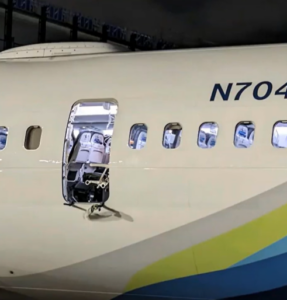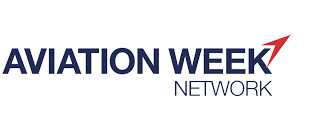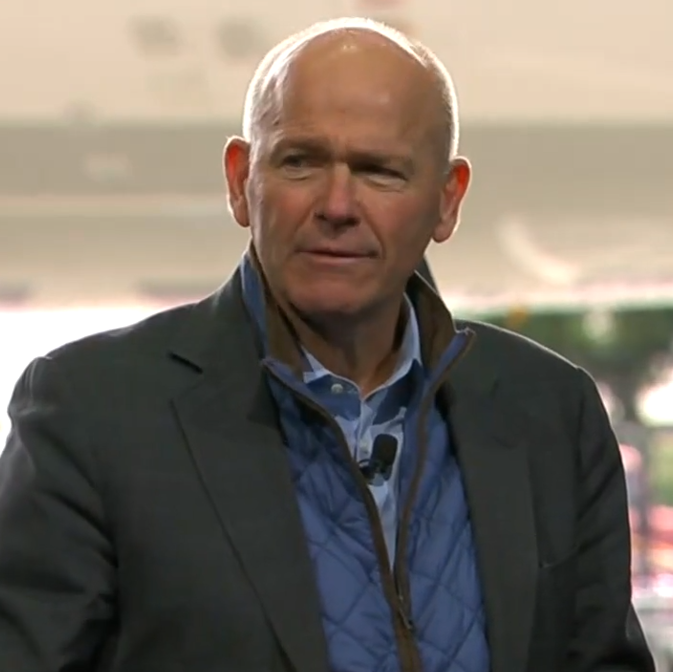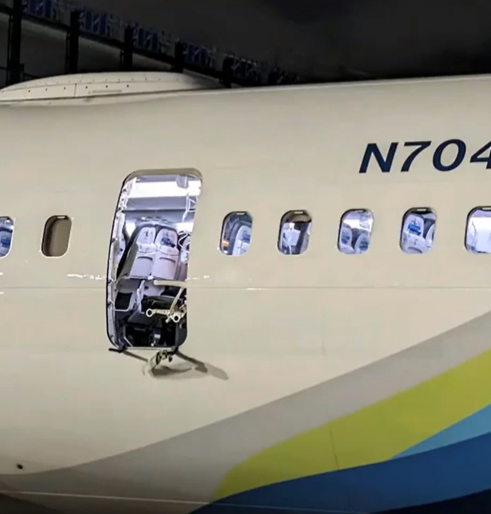Leeham News and Analysis
There's more to real news than a news release.
Boeing records loss in 2023, but better than expected results; no guidance for 2024
By Dan Catchpole
Subscription Required
 Jan. 31, 2024 © Leeham News: Boeing posted a $5.8B loss in 2023, a substantial improvement over the previous year’s $11B loss. Boeing Commercial Airplanes even posted a $41M profit in the fourth quarter–the first profitable quarter since the beginning of 2019.
Jan. 31, 2024 © Leeham News: Boeing posted a $5.8B loss in 2023, a substantial improvement over the previous year’s $11B loss. Boeing Commercial Airplanes even posted a $41M profit in the fourth quarter–the first profitable quarter since the beginning of 2019.
However, any progress made last year was erased on Jan. 5, when a door plug blew out on a two-month-old 737-9 MAX at 16,000 feet over Portland. An empty passenger seat was ripped, but nobody died and physical injuries were light on Alaska Airlines Flight 1282.
In an earnings report conference call with financial analysts, Boeing CEO David Calhoun said definitively that the accident was Boeing’s fault and that steps are being taken to ensure it never happens again.
Calhoun’s statements echoed similar declarations he made after taking over in 2019 as chief executive amid the MAX crisis following two fatal crashes.
Those crashes put the 737 program under global scrutiny.
“I’m still trying to get my head around how we got here,” Bank of America financial analyst Ron Epstein said during the call. After the two crashes, “wasn’t the 737 line, like the most scrutinized production line in the world? So, what happened to get to where we got today?”
Summary
- Boeing withdraws exemption request for 737-7
- Vague guidance for 2024
- More mea culpas
FCF: The Double-Edged Sword (an accounting primer)
By the Leeham News Team
Analysis
Jan. 30, 2024, © Leeham News: Boeing reports its year-end 2023 earnings tomorrow. Historically, Free Cash Flow (FCF) is a key metric officers like to promote, and aerospace analysts focus on.
 Before the 2019 grounding of the 737 MAX, Boeing returned 100% of FCF to shareholders via stock buybacks and dividends. Both returns were suspended by the end of 2019. Boeing set a goal in November 2022 of $10bn in FCF by 2025/2026, with the implication that shareholders will begin seeing a return then.
Before the 2019 grounding of the 737 MAX, Boeing returned 100% of FCF to shareholders via stock buybacks and dividends. Both returns were suspended by the end of 2019. Boeing set a goal in November 2022 of $10bn in FCF by 2025/2026, with the implication that shareholders will begin seeing a return then.
Free Cash Flow is generally understood to be the cash that flows into a company, less the cash outflows to pay for Operations and Capital Expenditures (Capex). It is the money that the company has available to repay its creditors or pay dividends and repurchase stock. It is also used to determine the financial health of an entity.
In the financial community, they are the buzzwords that investors love to hear.
Why is this relevant, especially for Boeing?
Culture change needed at Boeing; labor contract talks begin in March and could lead the way
A Leeham News Editorial
Jan. 29, 2024, © Leeham News: If Boeing is to emerge from its latest crisis unscathed, it will need to commit to a culture change. That’s the consensus of industry watchers, and it’s one that we whole-heartedly endorse.
 CEO Dave Calhoun will have a chance to show his commitment to that change starting in March, when Boeing Commercial Airplanes top management sits down with the bargaining team for its largest touch-labor union, IAM District 751.
CEO Dave Calhoun will have a chance to show his commitment to that change starting in March, when Boeing Commercial Airplanes top management sits down with the bargaining team for its largest touch-labor union, IAM District 751.
For 20 years, Boeing has prosecuted a scorched-earth fight against its unions, in the name of cost-cutting. It has outsourced work all over the globe. It has built a whole new campus in union-hostile South Carolina, primarily to escape the “hostage” situation it faced before, with all of BCA’s deliveries at the mercy of one unionized labor force.
 But while Boeing has won every battle in this long labor war, the result has not been a strategic victory. Instead, in 2024, the company finds itself badly trailing Airbus in both orders and deliveries, with little chance of catching up in the near term. This is in large part due to a series of high-profile self-inflicted failures, of which the near catastrophe on Alaska Flight 1282 on Jan. 5 is just the latest.
But while Boeing has won every battle in this long labor war, the result has not been a strategic victory. Instead, in 2024, the company finds itself badly trailing Airbus in both orders and deliveries, with little chance of catching up in the near term. This is in large part due to a series of high-profile self-inflicted failures, of which the near catastrophe on Alaska Flight 1282 on Jan. 5 is just the latest.
Boeing needs a top-to-bottom change of culture, and it can start by rebuilding its relationship with its touch-labor union.
- This year’s talks are the first in a decade.
- Boeing has zero leverage.
- Dropping union animus may be too much to ask.
Instead of progress, Boeing must deal with new crisis of Alaska Flight 1282 on Wednesday’s earnings call
Subscription Required
By Scott Hamilton and Judson Rollins
Jan. 29, 2024, © Leeham News: Twenty-twenty-four will be a crucial year for Boeing.

A door plug blew off a Boeing 737-9 MAX Jan. 5. The company must deal with the fallout on its 2023 year-end earnings call Wednesday. Credit: Capt. Chris Brady.
An unexpected twist is the crisis from Alaska Airlines Flight 1282, in which a door plug blew off a 737-9 MAX at 16,000 ft. Nobody died, and injuries were light. But the MAX 9 fleet was grounded in the US by the Federal Aviation Administration. The FAA launched a formal investigation into the “quality escape” that is believed to have led to the accident. Last week, the FAA put a freeze on current production rates of the 737 and, for now, killed Boeing’s plans to add a line at its Everett (WA) plant.
Beyond dealing with the 1282 aftermath, Boeing hopes this year to clear its inventory of 737 MAXes and the 787. Clearing the inventories brings cash and some profits. But will this move to the right while Boeing is under even more scrutiny by the FAA?
Boeing planned to be positioned for 2025 to pay down debt incurred during the MAX grounding and the COVID-19 pandemic. Progress toward free cash flow targets of $10bn per year by 2025/26 was forecast at its Nov. 2, 2022, investors day. This is almost certainly inoperative.
Leadership changes required at Boeing, say conference delegates
By Scott Hamilton
Analysis
Special Coverage of the Boeing Crisis
Jan. 26, 2024, © Leeham News: At the first commercial aviation conference following the Alaska Airlines Flight 1282 Boeing 737-9 accident on Jan. 5, much of the conversation was about the fallout to Boeing. Spirit AeroSystems was a topic of less conversation, even though the problem with 1282’s door plug appears to have originated with Spirit.
 Aviation Week’s supplier conference was supposed to begin with a fireside chat with Boeing’s Ihssane Mounir, the head of Boeing’s commercial supply chain. Unsurprisingly, Mounir canceled the week before as the Alaska accident—in which there were no fatalities and only a few minor injuries—expanded into a full-blown crisis for Boeing.
Aviation Week’s supplier conference was supposed to begin with a fireside chat with Boeing’s Ihssane Mounir, the head of Boeing’s commercial supply chain. Unsurprisingly, Mounir canceled the week before as the Alaska accident—in which there were no fatalities and only a few minor injuries—expanded into a full-blown crisis for Boeing.
News that the Federal Aviation Administration dropped the hammer on Boeing by freezing current 737 production rates and killing, for now, expansion of the airplane’s final assembly to the “North Line” in Everett (WA) brought disbelief that Boeing has fallen so far from what was once considered the Gold Standard of American engineering.
And, with contract negotiations beginning in March with its touch-labor union, the IAM 751, aerospace analyst Ron Epstein of Bank of America predicted that 751 has more leverage now than in recent years and Boeing will be in the weaker bargaining position.
Other than consultant Richard Aboulafia, a vociferous critic of Boeing CEO David Calhoun, speakers were willing to definitively call for changes in Boeing’s leadership. But in sideline talk, consensus was clear: “leadership” at Boeing headquarters and in Seattle with Commercial Airplanes has to go.
But there was no agreement, or even suggestions, about who should replace Calhoun and Stan Deal, the CEO of Commercial Airplanes.
FY and Q4 2023 Earnings: Hexcel’s Sales and Margins Expectations Miss Draw The Ire of Analysts
By Chris Sloan
Jan. 25, 2024, © Leeham News – Advanced composite materials maker Hexcel received a drubbing from analysts for reduced narrowbody sales in the most recent quarter. “This is the second quarter in a row that Hexcel has missed consensus expectations, and we used the sell-off last quarter to upgrade the stock, thinking it was a seasonal aberration,” said a sharply worded note from Vertical Research Partners Robert Stallard. The vexed analyst added,” Clearly, we were wrong, as Hexcel has missed again on every operating metric in 4Q. Given its established reputation as a quality aerospace company enjoying the OEM ramp, this performance is a jarring contradiction versus expectations.”
By The Numbers
 Overall, Hexcel’s Q4 2023 sales reached $457.5 million, up from $429.4 million in the fourth quarter of 2022. Hexcel’s largest corporate segment, commercial aerospace, increased 4.4%year-on-year to $267.5 million due to increasing demand and production rates for composite Airbus A350 and Boeing 787 airframes. This partially offset reduced Hexcel’s narrowbody sales for advanced materials for control surface, engines, and fuselage components for mainline workhorses A320s and 737s.
Overall, Hexcel’s Q4 2023 sales reached $457.5 million, up from $429.4 million in the fourth quarter of 2022. Hexcel’s largest corporate segment, commercial aerospace, increased 4.4%year-on-year to $267.5 million due to increasing demand and production rates for composite Airbus A350 and Boeing 787 airframes. This partially offset reduced Hexcel’s narrowbody sales for advanced materials for control surface, engines, and fuselage components for mainline workhorses A320s and 737s.
Vertical’s Stallard called this an 11% miss short of forecast. A Goldman Sachs First take piled on with, “4Q23 results are below consensus on revenue, margins, and EPS but ahead on free cash flow. Segment EBIT is 14% below consensus on revenue, which is 3% below.”
Hexcel achieved a full-year sales increase of 13.4% to $1,789 billion, up from $1,577 billion in 2022. Again, commercial aerospace, which constitutes 60% of corporate sales, lifted by 17.2% to $1,068 billion . The materials maker is guiding for mid-teens growth for FY 2024.
Updated: FAA grounds expansion plans for Boeing 737 MAX production, approves path for MAX 9s to resume flights
UPDATING (2)
- Hundreds of 737s scheduled for delivery this year and in coming years affected by FAA action.
- IAM shares concerns with Boeing, FAA.
By Dan Catchpole
Special Coverage of the Boeing crisis

The Federal Aviation Administration froze Boeing’s 737 production rate at the current level (31/mo, 372/yr) and for now killed expansion of a 4th line in Everett. Credit: Leeham News.
Jan. 24, 2024 © Leeham News: The Federal Aviation Administration said Wednesday it will not approve a planned expansion of Boeing 737 MAX production. The agency also laid out a path to get MAX 9 airplanes back flying.
The jetliners were grounded on January 6 after a door plug blew out the day before from a two-month-old 737 MAX 9 flown by Alaska Airlines. The FAA investigation found significant quality lapses in the program. Inspection of the MAX 9 fleet found problems in other airplanes.

A few of Alaska’s Boeing 737-9 MAXes parked at SEA-TAC International Airport awaiting return to service. Credit: Brandon Farris Photography.
After grounding the 171 MAX 9 airplanes operated by Alaska (65) and United Airlines (79), the FAA “made clear this aircraft would not go back into service until it was safe,” FAA Administrator Mike Whitaker said Wednesday in a public statement (Emphasis added). “The exhaustive, enhanced review our team completed after several weeks of information gathering gives me and the FAA confidence to proceed to the inspection and maintenance phase.
“However, let me be clear: This won’t be back to business as usual for Boeing. We will not agree to any request from Boeing for an expansion in production or approve additional production lines for the 737 MAX until we are satisfied that the quality control issues uncovered during this process are resolved,” he said.
“The quality assurance issues we have seen are unacceptable,” Whitaker said. “That is why we will have more boots on the ground closely scrutinizing and monitoring production and manufacturing activities.”
Culture key to latest Boeing MAX crisis: panelists
By Scott Hamilton
Special Coverage of the Boeing crisis
 Jan. 24, 2024, © Leeham News: What began as a non-fatal accident with an Alaska Airlines 737 MAX 9 on Jan. 5 has blown into a full crisis for Boeing. The company was once considered the gold standard of commercial aviation.
Jan. 24, 2024, © Leeham News: What began as a non-fatal accident with an Alaska Airlines 737 MAX 9 on Jan. 5 has blown into a full crisis for Boeing. The company was once considered the gold standard of commercial aviation.
Today, 171 737-9s remain grounded in the US by the Federal Aviation Administration (FAA). There is no end in sight as the FAA and National Transportation Safety Board (NTSB) investigate the accident of Flight 1282 in which a door plug (an inactive emergency exit) blew off the 10 week old Alaska MAX 9 on climb out from Portland (OR).
It is the second time the MAX has been grounded. All MAX 8s and MAX 9s were grounded from March 2019 for 21 months. This grounding only affects the MAX 9.
Evidence points to Boeing quality assurance flaws in final assembly. An anonymous Boeing employee posted on LNA a detailed scenario how Boeing failed its own processes in final assembly of the Alaska plane. (His post follows this article.)
The FAA is booting more inspectors on the ground at the 737 Renton factory. On Jan. 24, Boeing shut down the 737 assembly line for a “safety stand down.” CEOs of Alaska and United airlines, the two US carriers with the 171 MAX 9s on the ground, publicly eviscerated Boeing.
Related Articles
- Errors at Boeing (Seattle Times)
- Unplanned Removals, Installation Process at Boeing (Leeham News)
- Boeing turns to Admiral for the second time (Leeham News)
At the first aviation conference following the Alaska incident, the Aviation Week suppliers event, some speakers called for leadership changes at Boeing.
GE Aerospace’s Q4 and FY 2023 Earnings Draw Analyst’s Short-Term Shrugs and Long-Term Cheers
By Chris Sloan
 Jan. 23, 2024, © Leeham News – GE Aerospace’s last earnings season before morphing into a pure play engine maker ended on a disappointing note for some analysts. “Aero results were a bit short of our expectations, said a J.P. Morgan First Take Analyst Report, citing “missed estimates by 2% and 6% respectively for sales and EBIT.”
Jan. 23, 2024, © Leeham News – GE Aerospace’s last earnings season before morphing into a pure play engine maker ended on a disappointing note for some analysts. “Aero results were a bit short of our expectations, said a J.P. Morgan First Take Analyst Report, citing “missed estimates by 2% and 6% respectively for sales and EBIT.”
Despite an ascendant 38% YOY growth, LEAP deliveries bore the brunt of the blame for missing the forecast below management’s previous 40-45% guidance increase: “GE delivered 396 LEAPs in Q4, up only a touch sequentially and still down vs 2Q23. There seems to be some loss of momentum here, potentially due to supply chain challenges,” the report continued.
RTX FY and Q4 2023 Earnings: Pratt GTF Propulsion Prognosis Improves, Collins Enjoys Widebody Renaissance Tailwinds
By Chris Sloan
Jan. 23, 2024, (c) Leeham News:  RTX, the parent company of Pratt & Whitney and Collins Aerospace, reported during its fourth-quarter earnings call slivers of good news in the GTF program, which enters its ninth year of service – mostly in the headlines for the wrong reasons of poor reliability. Despite beating performance guarantees, the beleaguered powerplant family has been besieged by durability, operational, and production shortcomings since it entered service with the inauguration of Airbus A320neo service by Lufthansa back in January 2016 and EIS with the Bombardier C Series operated by Swiss (now Airbus A220) in July 2016.
RTX, the parent company of Pratt & Whitney and Collins Aerospace, reported during its fourth-quarter earnings call slivers of good news in the GTF program, which enters its ninth year of service – mostly in the headlines for the wrong reasons of poor reliability. Despite beating performance guarantees, the beleaguered powerplant family has been besieged by durability, operational, and production shortcomings since it entered service with the inauguration of Airbus A320neo service by Lufthansa back in January 2016 and EIS with the Bombardier C Series operated by Swiss (now Airbus A220) in July 2016.
The overall money metrics picture is upbeat despite weakness in military-based segments, higher production costs, and the continued Odyssey of the Pratt Geared TurboFan platform.
Pratt & Whitney reported an ascendant fourth quarter 2023 sales trajectory of $6.4 billion – up 14 percent versus the prior year. Commercial OE drove a 20% increase, while aftermarket rose 18%. Pratt reported $23.6 billion in sales for the entire year – an increase of 25%. Pratt’s full-year operating profit climbed by 25% versus 2023 to $382 million. The propulsion producer attributed its full-year profit growth to higher commercial aftermarket and OE mix.
Analysts were cautiously optimistic about the results. “While it’s no doubt a positive that the GTF is on track, there is still quite some way to go before RTX can declare ‘mission accomplished.’ But if RTX can hit its targets on GTF and also gradually improve the performance at Raytheon, then the stock looks inexpensive at 14.5x 2025 P/E,” said Vertical Research Analyst Robert Stallard.



